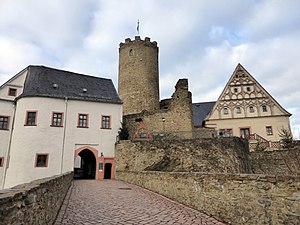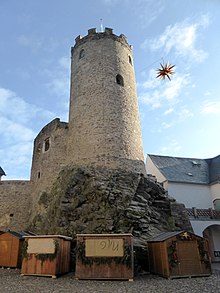Scharfenstein Castle (Ore Mountains)
| Scharfenstein Castle | ||
|---|---|---|
|
Scharfenstein Castle |
||
| Creation time : | around 1250 | |
| Castle type : | Höhenburg, spur location | |
| Conservation status: | Received or received substantial parts | |
| Standing position : | Nobles | |
| Place: | Drebach- Sharfenstein | |
| Geographical location | 50 ° 42 '17 " N , 13 ° 3' 18" E | |
|
|
||
The Scharfenstein Castle is a spur castle on an elongated mountain spur above the village of Scharfenstein , a district of Drebach in the Ore Mountains in the Free State of Saxony .
history
The original structure was built around 1250. The von Waldenburg is believed to be the builder , but only the first ownership is considered secure.
The von Waldenburg had a contiguous area with the dominions they owned, Waldenburg , Rabenstein , Scharfenstein and Wolkenstein , which stretched from the central Pleiße to the Erzgebirge ridge. The lords of the castle paid interest in 9 villages, including Grießbach , Großolbersdorf , Drebach and Herold . When Greifenstein Castle was destroyed in the 15th century, Scharfenstein also took over the protection of Thum, Ehrenfriedersdorf and Geyer. As a result, its value rose to such an extent that in 1439 the elector took over the territory of the Waldenburgers, who were heavily indebted to him.
On January 26, 1492, Heinrich von Einsiedel bought Scharfenstein Castle and the villages of Grießbach, Großolbersdorf, Grünau , Hohndorf , Hopfgarten and Scharfenstein.
In 1762, near the castle, in Gänsewinkel, Karl Stülpner , known as Wildschütz, was born. All sorts of legends entwine around his life, some of which also play on and around Scharfenstein Castle.
After the death of his brother Alexander Abraham von Einsiedel in 1798, Kurt Heinrich von Einsiedel transferred the manor and accessories to his feudal cousins from the Lumpzig line during his own lifetime 1803/1804 , as there were no male descendants from his line.
In 1803/04, Friedrich Hildebrand von Einsiedel (1750–1828) and his brothers became co-owners of the manor with castle and accessories. Friedrich Hildebrand was chamberlain to the duchess Anna Amalia of Saxe-Weimar-Eisenach and a prominent figure in the Weimar Classicism circle . However, he hardly visited Scharfenstein. The administration of Scharfenstein initially received the youngest brother Heinrich Ludwig von Einsiedel (1770–1842) around 1804. He was a Saxon captain and took up residence on Scharfenstein. Otherwise, the brother August von Einsiedel was entrusted and authorized to organize the clarification of legal questions in connection with the takeover of the feudal fief and other problems in relation to Scharfenstein . In 1810 and 1812 the brothers - with the exception of the ailing and thus reluctant to travel Hildebrand von Einsiedel - came to Scharfenstein. In 1812 the other brother, Rittmeister Alexander von Einsiedel, took over the administration of Scharfenstein and lived there. In 1825 August von Einsiedel, his wife Emilie von Einsiedel (1757–1844) and their son Friedrich August von Einsiedel (1793–1833) also took up residence on Scharfenstein. One of the most scandalous stories of Goethe's time (read in the article about August ) revolved around the latter couple, who also belonged to the Weimar Muse circle .
The entire residential wing and part of the social wing were destroyed by a fire on the night of June 1 and 2, 1921. Based on the old design, it was partially rebuilt from 1921 to 1923 according to plans by Bodo Ebhardt . The castle remained in the family's possession until 1931.
In 1931, factory owner Hauptmann Eulitz from Fährbrücke acquired the property. Through his work, a bird protection station was established in 1932. Hundreds of nest boxes were hung in the 325 hectare forest area that belonged to the property, ringing was carried out and scientific reports were published with the support of the Chemnitz Ornithological Society.
In 1945 this forest area became public property , the castle was initially set up as a mountain school in Wismut and in 1951 a special children's home for "difficult to educate" boys. In 1967 it was converted into a youth work center for young people who were also considered "difficult to educate" in terms of GDR pedagogy. The ornithological work was done by the museum at Augustusburg Castle.
In 1993 the castle was taken over by the Free State of Saxony - Saxon Palace Administration. In the period that followed, the castle was renovated and converted into a museum . When the renovation work was completed in 1995, various exhibitions were opened - for the first time since 1945 the castle is open to the public again.
Todays use
The Scharfenstein Castle houses the "Christmas and Toy Museum" and an exhibition on folk art. The ballroom and other rooms can be used for celebrations and events, and weddings are carried out in the festive wedding hall. The 17 meter high keep is now used as a lookout tower and offers a very good view of the Zschopau valley.
literature
- Otto Eduard Schmidt : The resurrected Scharfenstein Castle on the Zschopau . in: Communications of the Landesverein Sächsischer Heimatschutz Volume XIII, Issue 9–10 / 1924, Dresden 1924, pp. 316–332
- Richard Steche : Scharfenstein. In: Descriptive representation of the older architectural and art monuments of the Kingdom of Saxony. 5th issue: Amtshauptmannschaft Marienberg . CC Meinhold, Dresden 1885, p. 28.
- Unger, Roland (ed.): FvS, Carl Stülpner a notorious poacher in the Saxon Ore Mountains. The first biography of Stülpner, recorded by Friedrich von Sydow. H&F Verlag Scheibenberg 1998.
Web links
Veit Noll: The Lords of Einsiedel as landowners of Scharfenstein near Zschopau at the end of the 18th / beginning of the 19th century. Http://www.august-einsiedel.de/index.php/einzelnes/12-scharfenstein-im-erzgebirge
Individual evidence
- ↑ a b cf. The middle Zschopau area (= values of our homeland . Volume 28). 1st edition. Akademie Verlag, Berlin 1977, pp. 187-189.
- ↑ Welcome to Scharfenstein Castle on the Drebach community website









